Choosing the correct Ethernet cable category for your network
In 1973, Bob Metcalfe invented a high-speed networking system called Ethernet to allow computer workstations, servers and printers to share data and resources. Today, Ethernet connects hundreds of millions of devices in homes and businesses.

Buying Ethernet Cable for your Network
If you are buying Ethernet cable for the first time, focus on these four features and you'll be able to make a good decision.
- Speed (Data Rate): the speed of a cable refers to the amount of data it can transmit per second. 100 Mbps means the cable can transmit 100 million bits of data a second. In a commercial network, speed is usually dictated by the equipment you are connecting (for example, a network switch with Gigabit Ethernet ports). In the home, choose a cable that can support the speed of your Internet connection, plus some room for speed upgrades in the future. A cable's Category designation (e.g. Cat5e, Cat6, etc.) is an easy way to identify the speed of a cable.
- Shielding: some Ethernet cables are shielded to protect the cable's conductors from electromagnetic interference (EMI) caused by power lines, large machinery and fluorescent lighting. Shielding also prevents parallel conductors inside the cable jacket from interacting with one another.
- Cable Length: The maximum length of an Ethernet cable is about 295 feet (90 meters). Good quality cables with shielding and thicker conductors can reach further but some trial and error will be required. Keep in mind that cable runs are rarely straight so plan on extra cable for some twists and turns.
- Installation Location: cable jackets are rated for fire safety. If you plan on running cable through walls or between floors, choose rise-rated (CMR) or plenum-rated (CMP) cable. Ethernet Cable Categories
Ethernet Cable Categories
The "Cat" in Cat5e, Cat6, etc. is short for "Category." Network cables are divided into categories based mainly on bandwidth (measured in MHz), maximum data rate (measured in megabits per second) and shielding.
Cat1
For a time, this unshielded twisted pair (UTP) cable was the most common form of wiring for voice telephone systems in homes and offices. It consisted of two insulated copper wires twisted around each other and was designed for analog voice communications.
Cat2
Category 2 cabling was capable of voice and data communications and was primarily used during the 1980s for IBM Token Ring networks. It supported a data transmission rate of 4 Mbps.
Cat3
Introduced in the early 1990s, Category 3 cabling had four twisted pairs and was the first to support 10BaseT Ethernet networks as well as digital voice communications. It is still found in older buildings but its 10 Mbps data rate is considered too slow for modern networking.
Cat4
Like Cat3, Category 4 cable is typically found in older buildings where the cost of complete replacement is prohibitive. It had a data rate of 16 Mbps and was primarily used for IBM Token Ring networks.
Cat5
Introduced in 1995, Category 5 cable has a data rate of up to 100 Mbps. It is used for standard 10BaseT and 100BaseT (Fast Ethernet) networks, and can distribute data, video and telephone signals at distances up to 100 meters (328 ft.). Cat5e is not an official designation but is used by manufacturers to describe an enhanced Cat5 cable that is capable of speeds up to 1 Gbps. Its higher data rate is achieved by increasing the number of twists, making it more resistant to crosstalk. Cat5e is recommended for new sub-Gigabit network installations.
Cat6
In comparison to Cat5e, Cat6 cable provides greater bandwidth and data transfer rates up to 1 Gbps over 100 m, the same as Cat5e. However, at shorter distances of up to 37 m (121 ft.), Cat6 is able to achieve 10 Gbps speeds thanks to its improved shielding and higher bandwidth. Cat6 includes a physical separator called a "spline" between the four pairs to reduce crosstalk and foil shielding to reduce electromagnetic interference. Cat6 cabling is backward compatible with the Cat5/5e standard. Introduced in 2009, Cat6a is an "augmented" Category 6 cable with a bandwidth of up to 500MHz.
Cat7
The Cat7 specification is a proprietary standard developed by a consortium of companies and is not endorsed by IEEE or TIA/EIA. While substantially similar to the performance characteristics of Cat6a, Cat7 cables features proprietary GG45 connectors and robust shielding. Cat7a (Category 7 Augmented) is a further refinement of Cat7, capable of 40 Gigabit speeds over 50 meters and 100 Gbps up to 15 meters. The proprietary nature of the Cat7 and Cat7a standards and lack of support from IEEE and EIA has resulted in a relatively small installed based for Cat7/Cat7a.
Cat8
With a bandwidth of up to 2 GHz (2000 MHz) over 30 meters and a data rate of up to 40Gbs, Cat8 cable is ideal for switch-to-switch communications in a 25GBase T or 40GBase T network. Its conductors are wrapped in foil to virtually eliminate crosstalk and enable higher data rates. The result is a heavier gauge cable that is quite rigid and can be difficult to install in tight spaces. It still uses RJ45 connectors and is backwards compatible with previous standards.
| Category | Max. Data Rate | Bandwidth | Max. Distance | Usage |
|---|---|---|---|---|
| Category 1 | 1 Mbps | 0.4 MHz | Telephone and modem lines | |
| Category 2 | 4 Mbps | 4 MHz | LocalTalk & Telephone | |
| Category 3 | 10 Mbps | 16 MHz | 100 m (328 ft.) | 10BaseT Ethernet |
| Category 4 | 16 Mbps | 20 MHz | 100 m (328 ft.) | Token Ring |
| Category 5 | 100 Mbps | 100 MHz | 100 m (328 ft.) | 100BaseT Ethernet |
| Category 5e | 1 Gbps | 100 MHz | 100 m (328 ft.) | 100BaseT Ethernet, residential homes |
| Category 6 | 1 Gbps | 250 MHz | 100 m (328 ft.) 10Gb at 37 m (121 ft.) |
Gigabit Ethernet, commercial buildings |
| Category 6a | 10 Gbps | 500 MHz | 100 m (328 ft.) | Gigabit Ethernet in data centers and commercial buildings |
| Category 7 | 10 Gbps | 600 MHz | 100 m (328 ft.) | 10 Gbps Core Infrastructure |
| Category 7a | 10 Gbps | 1000 MHz | 100 m (328 ft.) 40Gb at 50 m (164 ft.) |
10 Gbps Core Infrastructure |
| Category 8 | 25 Gbps (Cat8.1) 40 Gbps (Cat8.2) |
2000 MHz | 30 m (98 ft.) | 25 Gbps/40 Gbps Core Infrastructure |
What type of Ethernet cable should I buy for my home network?
Even with a speedy WiFi6 router, your connection to the Internet is usually the bandwidth bottleneck. Currently, the fastest Internet plans available from the major carriers offer download speeds of 1 gigabit per second (1,000 Mbps). If you already have the fastest Internet access available from your provider, use Cat6a cable. This will give you some headroom for future speed increases. For Internet download speeds up to a gigabit, Cat5e is a good choice. You'll save a little money over Cat6a and the thinner cable will be easier to install.
Ethernet Cable Length
The further a signal has to travel along a cable, the more it will degrade (a process known as attenuation) until it reaches the point where it can no longer be detected, or is too distorted to be interpreted by the receiving device. Attenuation can also be caused by noise due to electrical currents and radio frequencies. Cables with shielding to minimize noise will work reliably over greater distances.

The maximum length of a Cat5e or Cat6 Ethernet cable is about 295 ft. (90 m), plus up to 16 ft. (5 m) of patch cable on either end, for a total of 328 feet or 100 meters. Beyond this, the signal begins to degrade, reducing the speed and reliability of the connection. Good quality cable can support runs in excess of 100 meters but data transmission speed may be reduced. Higher data rates can also be achieved over shorter distances.
Ethernet Cable Shielding

Unshielded Twisted Pair (UTP)

Shielded Twisted Pair (STP)
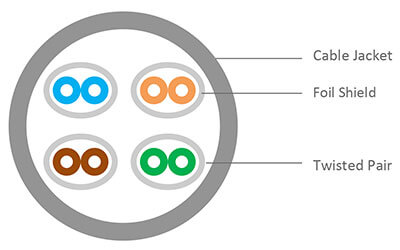
Foiled Twisted Pair (FTP)

Outer Foil Shield/Unshielded Twisted Pair (F/UTP)
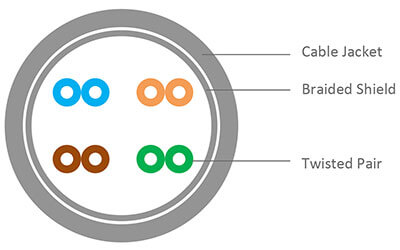
Outer Braided Shield/Unshielded Twisted Pair (S/UTP)
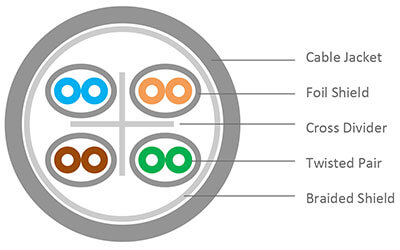
Outer Braided Shield/Foiled Twisted Pair (S/FTP)
Ethernet Patch Cords and Connector Styles
Termination
Ethernet cables made from four twisted pairs are terminated using an 8-pin RJ45 connector. Older telephone cable based on two twisted pairs typically use RJ11 connectors.
The terms 8p8c (Eight Position, Eight Contact) and RJ45 are often used interchangeably but 8p8c actually refers to a category of connectors of which RJ45 is one. The modern RJ45 Ethernet connector is the most common example of an 8p8c connector.
GG45 (GigaGate 45) or ARJ45 (Augmented RJ45) is a connector originally developed by French cable company Nexans for use with Cat7 cable. GG45 connectors have 12 pins in total, 8 providing backwards compatibility with Cat6, and an additional 4 pins providing support for frequencies of up to 600MHz.
M12 coded connectors are found on Ethernet cords designed for industrial applications. These cables are often exposed to vibration, extreme temperatures and moisture. The threaded connectors are designed to provide a waterproof and secure connection.

Why is an Ethernet cable connector called RJ45?
"RJ" stands for Registered Jack and refers to a standardized physical network interface. The "45" simply refers to the number of the interface in the standard specification.
Connector Styles
Molded connectors are permanently attached to a cable using a manufacturing process called over-molding. The connector and cable are covered with a thermoplastic or silicon material to form one solid piece called a boot, making the cable more durable and able to withstanding a high number of insertion cycles.

Snagless connectors have a modified boot that protects the connector's lock from being accidentally snapped off. Snagless cables are typically used in situations where the cable is frequently connected and disconnected, such as a laptop-to-wall network connection.

Cable Styles
Slim and Ultra-Slim Cables
Slim and Ultra-Slim cables have a diameter that's typically 30-50% less than that of a standard Cat6 cable. Manufactured from small gauge copper wire, the four-pair stranded cable increases airflow in crowded equipment racks, which helps keep components cool and functioning properly. The slim design also makes the cable lighter and easier to install in high-density racks, cable trays and ductwork.
Flat Cables
Although not a common choice, flat cables have some unique characteristics that make them beneficial in certain applications. Flat cables have good heat dissipation and more evenly distribute physical loads on the cable. They also bend only through the wide faces whereas a conventional round cable bends in all directions.
A flat cable is a good choice if you need to carry an Ethernet patch cable around in your laptop bag. It is strong, light and will not tangle easily. Its flat shape makes it ideal for cable runs under carpet and behind baseboard.
Solid Core Cables
Network cables are available in stranded and solid wire formats. As the name suggests, a solid core cable uses one solid copper wire for each conductor, so a 4-pair cable will have a total of 8 solid copper wires. Solid conductor cable is easy to punch down, making it ideal for structured wiring applications.
In situations where a cable is repeatedly flexed or connected and disconnected, choose a stranded cable. For horizontal cable runs not subject to repeated movement, or for Power-over-Ethernet (PoE) and outdoor applications, use solid core cable.
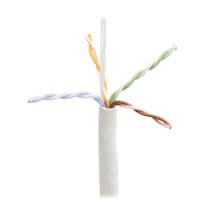
Armored Cable
The outer jacket of an armored cable is made from thermoplastic polyurethane (TPU), a type of polyurethane known for its strength, flexibility (even in low temperatures) and cut/abrasion resistance. Armored cable is recommended for outdoor applications and any location where the cable could potentially be crushed or cut.

What is a Crossover Cable?
There are two wiring standards used by RJ45 connectors, referred to as T568A and T568B. The difference is the pin assignment for the green and orange pairs. T568A pinouts are the most commonly used but either will work so long as both ends of the cable are similarly wired. The U.S. Government requires the use of the T568A standard for networks installed under a federal contract.
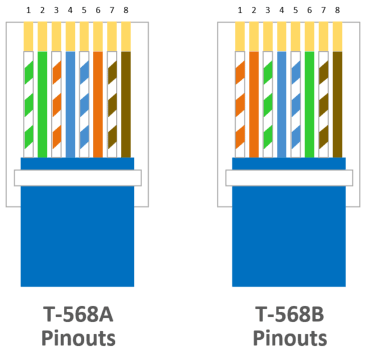
| PIN | SIGNAL | T568A | T568B |
|---|---|---|---|
| 1 | TX+ | White/Green | White/Orange |
| 2 | TX- | Green | Orange |
| 3 | RX+ | White/Orange | White/Green |
| 4 | TRD2+ | Blue | Blue |
| 5 | TRD2- | White/Blue | White/Blue |
| 6 | RX- | Orange | Green |
| 7 | TRS3+ | White/Brown | White/Brown |
| 8 | TRS3- | Brown | Brown |
Wiring 8-Position RJ45 Modular Plugs: T568A and T568B Wiring Patterns
Cables with T568A wiring on one end and T568B on the other are known as "crossover" cables. You can identify a crossover cable by comparing the order of wires on each end. If the wires are the same on each end (regardless of which pin configuration is used), it is a "straight-through" cable. If they are different, it is a crossover cable.
Nowadays, most Ethernet switches and routers have a feature called auto-MDIX, which can detect which type of port or cable (crossover or straight-through) is connected and swap the transmit and receive pins accordingly, removing the need for crossover wiring.
Gauge
One of the factors limiting the length and data rate of Ethernet cable is the size of its conductors. Electrical current encounters greater resistance when transmitted over thinner wire. The larger the conductor, the easier it is for the electrons to pass through it resulting in lower resistance, lower signal loss and greater transmission distance.
The diameter or gauge of a cable's conductor is referred to using American Wire Gauge (AWG) standard sizes. For example, a 24 AWG solid conductor is 0.0201 inches in diameter. A 28 AWG conductor is 0.0126 inches in diameter, almost half the size.
| Cable Type | Typical Gauge | Diameter (inches) | Diameter (mm) |
|---|---|---|---|
| Cat8 | 22 AWG | 0.0253 | 0.6438 |
| Cat6/Cat6a | 23 AWG | 0.0226 | 0.5733 |
| Cat5e | 24 AWG | 0.0201 | 0.5106 |
| Slim Cat6 | 28 AWG | 0.0126 | 0.3211 |
| Ultra Slim Cat6 | 32 AWG | 0.0080 | 0.2019 |
Conductor gauge affects a cable's performance but is typically not the most important factor. Shielding and twist rate have more impact on signal strength and quality.
Twist Rates

Today, twisting conductor pairs is a common way to minimize signal interference and crosstalk, and increase cable performance. The twist rate or "pitch" is usually measured as the number of twists per inch or centimeter.
Twist Rate is not specified in the IEEE or TIA category cable standards and is left to the manufacturer to decide. Cat5e typically has a twist rate of 4-5 twists per inch whereas Cat6 cables have a twist rate of 5 or more twists per inch. To further reduce crosstalk, not all conductor pairs in a cable will have the same twist rate.
Jacket Ratings
Jackets protect the cable's conductors from physical damage, moisture and ultraviolet light. When installing cable in walls, ceilings and under floors, it is important to use cables that meet the local code requirements (usually based on the NFPA's National Electric Code). The three basic ratings for both cable types are general purpose, riser and plenum-rated.
| Jacket Rating | Description | Applications | Acceptable Substitute |
|---|---|---|---|
| CM/CMG | Communications, General Purpose | Patch cables. In-room cable runs. Not for use in risers and plenum. |
CMR, CMP |
| Riser (CMR) | Communications, Riser A riser is a vertical space, typically inside walls and between floors |
In-wall installation May be required due to insurance or contractual clauses |
CMP |
| Plenum (CMP) | Communications, Plenum Plenum is space above and below floors typically occupied by heating and air conditioning ductwork |
Air ducts and plenums above and below floors. May be required due to insurance or contractual clauses. |
|
| Outdoor (CMX) | Outdoor LDPE (low-density polyethylene) |
Exterior installation. Buried or exposed to moisture or UV light. Cable runs up to 50-ft. |
Special Applications
Power over Ethernet (PoE)
PoE allows both power and data to be delivered over a single, solid core category cable. This makes it ideal for networking IP devices like security cameras, access control readers, wireless access points (WAPs), sensors and lighting that require DC power and a data network connection. PoE gives you the flexibility to install devices where you need them without having to worry about access to AC power.
Limited Power (LP) Applications
UL has developed a Limited Power Certification for Power-over-Ethernet (PoE) applications. The LP designation, first introduced in 2015, indicates that a cable has been tested under "reasonable worst case installation scenarios" and is capable of carrying the stated current without exceeding the temperature rating of the cable. The LP designation is particularly important in PoE++ applications where power exceeds 60 watts.
Outdoor Cable
Exterior-grade CMX Ethernet cable is waterproof and resistant to drying and cracking after long-term exposure to the sun. It can also be buried in the ground without a conduit. Also consider cable and hooded connectors with an IP68 rating.
Plenum Spaces and Risers
Plenum is the space above or below a room that provides a way for air to return to a building's HVAC system. A riser is a vertical shaft between floors for electrical wiring, water pipes, and voice or data cabling. In the event of a fire, it's critical that cabling in these areas does not promote the spread of smoke and toxic fumes.
When selecting cable to run through plenum or risers, look for products with a jacket rating of CMP (plenum) or CMR (riser). These cables have a higher degree of fire resistance and emit fewer toxic fumes compared to general purpose CM or CMG rated cables. In the US, the NFPA's National Electrical Code (NEC) guidelines requires CMP or CMR cabling for plenum or risers and compliance may be a contractual or legal requirement. Because CMP cables have a higher fire resistance, you can use CMP in risers but you cannot use CMR cable in plenum spaces.
Anti-Bacterial Cables
The jacket on these cables is constructed using an antibacterial material that is 99.9% effective in inhibiting Escherichia coli (E. coli) and Staphylococcus aureus (staph). This added protection makes these cables an ideal solution for high-touch applications and in environments where bacterial infection is of particular concern, such as medical facilities, schools, process manufacturing and restaurants/kitchens.
Choosing Ethernet Cables
What is the difference between Cat5 and Cat6?
Cat6 and Cat6a cables are more expensive than Cat5e so it's important to know what you're getting for your money. For cable runs up to 50-ft, Cat6 is capable of 10 Gbps vs. 1 Gbps for Cat5e. For longer runs, Cat5e and Cat6 should give similar performance.
Should I upgrade from Cat5e to Cat6?
Upgrading to Cat6 makes sense if the equipment on either end is capable of 10 Gbps. For example, core network connections between switches, routers or bridges would benefit from the higher bandwidth.
Are Cat8 cables worth the extra money?
Cat8 is designed for switch-to-switch communications in 25G and 40G networks. Residential and commercial projects outside the data center would be better using Cat6a cable. Not only is it less expensive, it's also easier and faster to install.
Can you mix Cat5 and Cat6 cable in a network?
There's no problem in mixing Cat5e and Cat6 cable in the same network so long as you don't create a bottleneck. Use Cat6 in the parts of your network where fast data transfer is important, such as between a switch and a router.
Are all Cat6 cables the same?
All good quality cables that have been tested and certified by the manufacturer for a certain bandwidth and data rate are essentially the same. Shielded Cat6 and Cat6a cable will give you better performance than unshielded, particularly when cables must be run in close proximity to power lines or large electrical equipment.
Do cheap cables work just as well?
In a word, no. Category cables are made of solid or stranded copper but some companies sell cheap versions made with Copper Clad Aluminum (CCA), an aluminum conductor that is coated with copper. These cables are cheaper to manufacture but result in a weaker cable that does not perform as well.
Big Cat Cables presents the information on our website, including the blog and live chat support, as a service to our customers and other visitors to our website subject to our website terms and conditions. While the information on this website is about data networking and electrical issues, it is not professional advice and any reliance on such material is at your own risk.



